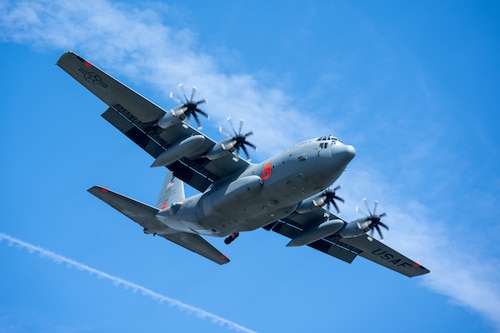Military and civilian flight crews wrapped up a week of aerial wildfire suppression training on April 27, concluding the annual Modular Airborne Firefighting Systems spring training at Channel Islands Air National Guard Station in southern California.
The training, which ran April 22-27, brought personnel together from the U.S. Department of Agriculture Forest Service and other federal agencies, along with Airmen from the Nevada Air National Guard's 152nd Airlift Wing, the Wyoming Air National Guard's 153rd Airlift Wing, the Air Force Reserve's 302nd Airlift Wing from Colorado and the California Air National Guard's 146th Airlift Wing.
The Modular Airborne Firefighting Systems training recertified military C-130 Hercules's aircrews, civilian lead plane pilots and federal and state support personnel to respond to wildfires when commercial air tankers are unavailable.
Col. Catherine Grush, 152nd Airlift Wing commander, praised the longstanding partnership.
"Our citizen Airmen are grateful for the opportunity to work with all agencies involved and to support our neighbors in their times of need," Grush said.
Throughout the exercise, crews completed 84 training sorties, logged nearly 129 flight hours and executed 478 practice water drops, totaling 235,327 gallons. Practice drops were conducted in designated remote areas of the Angeles National Forest in Los Angeles County, where residents may have noticed low-flying aircraft during the week.
The training was extended through April 28 to allow Colorado Springs-based crews additional flight time after weather and aircraft maintenance delayed operations earlier in the week. Aircraft and personnel from Nevada and Wyoming completed their training and returned home April 27, while Colorado crews departed April 28.
The MAFFS units, owned by the Forest Service, can discharge their entire load of up to 3,000 gallons of material to stop fires from spreading in less than five seconds, covering an area one-quarter of a mile long by 100 feet wide, or they can make incremental drops. Once a load is discharged from a MAFFS-equipped aircraft, and the aircraft lands at a tanker base, it can be refilled in less than 12 minutes. The modular systems are loaded into the back of military C-130 Hercules aircraft and provide critical surge capacity during peak wildfire activity.
"The MAFFS program is a unique and vital mission and it's a privilege to be part of it," said Lt. Col. Matthew Schwegel, Nevada Air National Guard,152nd Airlift Wing pilot. "Our crews take tremendous pride in being trained, ready, and able to answer the call when the nation needs us."
This year, MAFFS-equipped aircraft were already activated early, supporting firefighting efforts in January on the Palisades and Eaton fires in the Los Angeles area.







